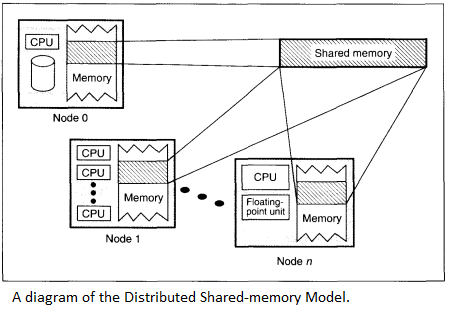CSC/ECE 506 Spring 2012/2a va
SAS programming on distributed-memory machines
Introduction
Decades ago, shared memory programming model was always implemented on shared memory hardware, while message-passing programming model was adopted on distributed memory hardware. However, nowadays the boundary has been broken. With the support of a shared virtual memory layer, we can program in shared memory fashion on distributed memory hardware. This article discusses how the shared-memory programming model is implemented on distributed-memory hardware.
Overview of Parallel Processing
Two Memory Models
In order to be effective, parallel processing must be supported on both a software level and a hardware level, with the appropriate systems in between. Two different memory models have been developed which handle parallel processing in distinct ways.
This model is widely considered to be the most straightforward to program for. The main shortcoming of this model, however, is that it does not scale well due to the fact that the processors must share a common bus which serializes a significant portion of communication.
Distributed-memory
This model has the opposite strengths and weaknesses of the shared-memory model. It scales well as long as the machines are on a highspeed network, but the message-passing model associated with distributed-memory systems is much more difficult to program for.
Hybrid Model
SAS programming on distributed-memory machines is an attempt to give us the best of both the shared-memory model and the distributed memory model. Frequently referred to as the distributed shared-memory model or DSM, it uses a virtual address space or similar abstraction which gives the impression that the memory is shared even though it isn’t<ref>http://citeseerx.ist.psu.edu/viewdoc/download?doi=10.1.1.17.7084&rep=rep1&type=pdf</ref>
Efficiency
DSMs are less efficient than a straight message passing system. The reason for this is that under the message passing model, the programmer is aware of when messages need to be passed and can program for those situations. With the DSM model, the programmer programs as if no messages need to be shared, but the DSM system must handle and attempt to anticipate when messages will need to be sent without knowing what applications will be running on it or how those applications have been programmed. <ref>http://citeseerx.ist.psu.edu/viewdoc/download?doi=10.1.1.52.4066&rep=rep1&type=pdf</ref>

Accessing Remote Data
In the DSM, the system has to do a lookup for each reference to figure out if the data is local. If it’s not, a protocol action is invoked to acquire the data locally. This is referred to as access control.<ref>http://ftp.cs.wisc.edu/pub/techreports/1994/TR1238.pdf</ref> This is implemented in a variety of ways, including both hardware and software only solutions, as well solutions that include both hardware and software elements. All of these efforts are made in an attempt to bring the efficiency of the DSM model closer to that of a well-programmed message passing model. The efficiency issue with DSM boils down to how remote data is both stored and retrieved. There have been several different approaches to this problem
Static Data
Simply making the location of data within the overall system static solves the problem of how to find the data. This approach, however, creates a new problem of making sure that the data is properly distributed throughout the system. If all of the data ends up on a single node, this will create problems as multiple processes try to access the same data.
Dynamic Data
All other approaches to accessing remote data assume that data will move throughout the system as needed, and thus involve some way of keeping track of this data.
Centralized Server
This approach greatly simplifies the task of finding remote by having a single server keeping track of data as it moves around the system. The problem with this approach is that it serializes the task of finding remote memory locations, which all but defeats the purpose of having a parallel system in the first place.
Broadcasting
The broadcasting approach is for the node needing the data to send a message out to all the nodes in the system in order to find the one with the data. The problem with this approach is that it creates a lot of overhead as every node has to process the broadcast.
Owner based distribution
This system keeps track of the original owner of each piece of data. A node which needs the data then queries the original owner of the data, which passes the request off to the new owner if it has moved. This can result in excessive forwarding.<ref>http://www.cdf.toronto.edu/~csc469h/fall/handouts/nitzberg91.pdf</ref>
References
<references></references>